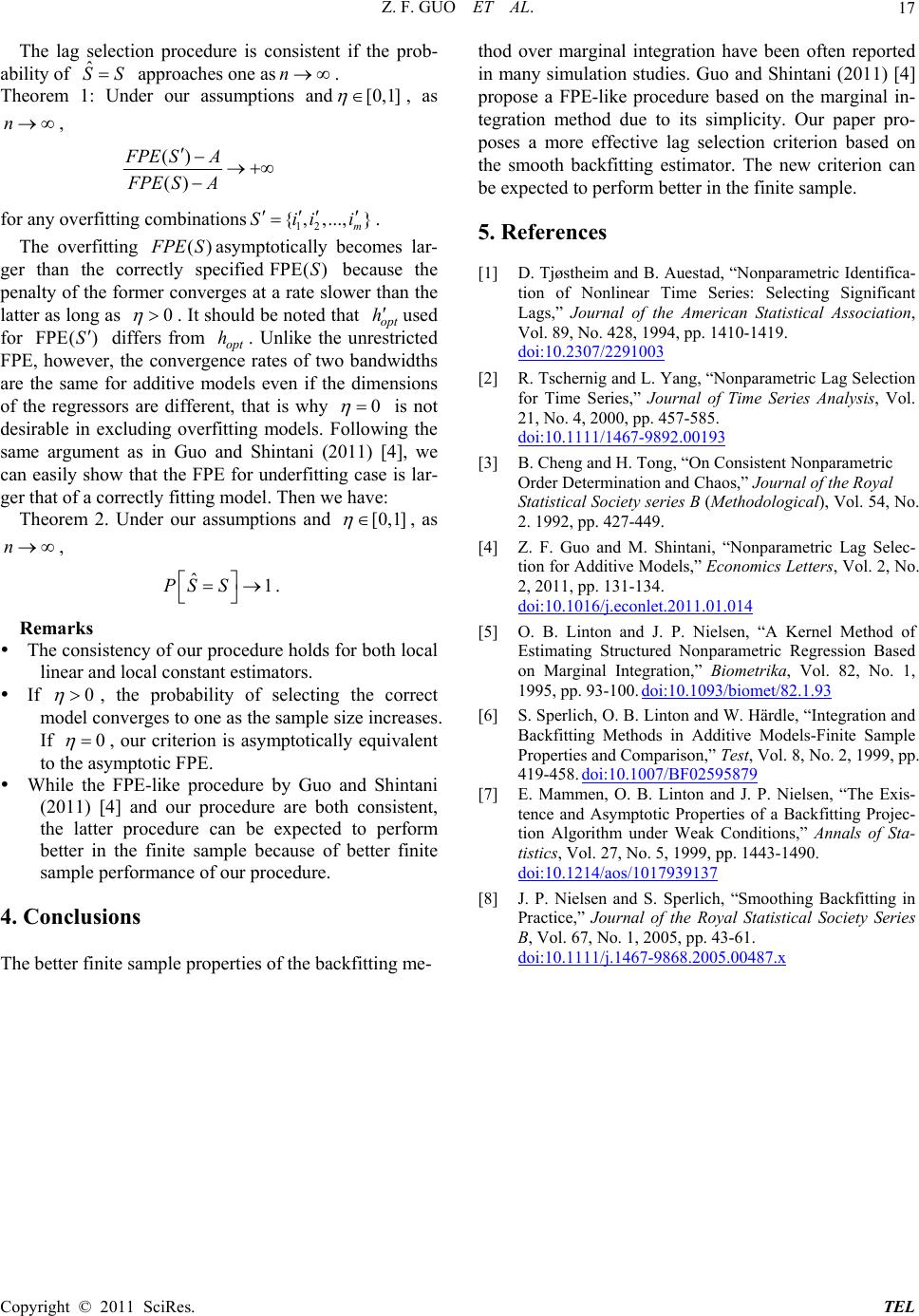
Z. F. GUO ET AL.
Copyright © 2011 SciRes. TEL
17
The lag selection procedure is consistent if the prob-
ability of approaches one as.
ˆ
SSn
Theorem 1: Under our assumptions and[0,1]
, as
,
n
()
()
FPE SA
FPE SA
for any overfitting combinations.
12
{, ,...,}
m
Siii
The overfitting ()
PE S
0
asymptotically becomes lar-
ger than the correctly specified because the
penalty of the former converges at a rate slower than the
latter as long as
FPE( )S
. It should be noted that opt
h
used
for differs from opt . Unlike the unrestricted
FPE, however, the convergence rates of two bandwidths
are the same for additive models even if the dimensions
of the regressors are different, that is why
FPE( )Sh
0
is not
desirable in excluding overfitting models. Following the
same argument as in Guo and Shintani (2011) [4], we
can easily show that the FPE for underfitting case is lar-
ger that of a correctly fitting model. Then we have:
Theorem 2. Under our assumptions and [0,1]
, as
,
n
ˆ1
PS S
.
Remarks
The consistency of our procedure holds for both local
linear and local constant estimators.
If 0
, the probability of selecting the correct
model converges to one as the sample size increases.
If 0
, our criterion is asymptotically equivalent
to the asymptotic FPE.
While the FPE-like procedure by Guo and Shintani
(2011) [4] and our procedure are both consistent,
the latter procedure can be expected to perform
better in the finite sample because of better finite
sample performance of our procedure.
4. Conclusions
The better finite sample properties of the backfitting me-
thod over marginal integration have been often reported
in many simulation studies. Guo and Shintani (2011) [4]
propose a FPE-like procedure based on the marginal in-
tegration method due to its simplicity. Our paper pro-
poses a more effective lag selection criterion based on
the smooth backfitting estimator. The new criterion can
be expected to perform better in the finite sample.
5. References
[1] D. Tjøstheim and B. Auestad, “Nonparametric Identifica-
tion of Nonlinear Time Series: Selecting Significant
Lags,” Journal of the American Statistical Association,
Vol. 89, No. 428, 1994, pp. 1410-1419.
doi:10.2307/2291003
[2] R. Tschernig and L. Yang, “Nonparametric Lag Selection
for Time Series,” Journal of Time Series Analysis, Vol.
21, No. 4, 2000, pp. 457-585.
doi:10.1111/1467-9892.00193
[3] B. Cheng and H. Tong, “On Consistent Nonparametric
Order Determination and Chaos,” Journal of the Royal
Statistical Society series B (Methodological), Vol. 54, No.
2. 1992, pp. 427-449.
[4] Z. F. Guo and M. Shintani, “Nonparametric Lag Selec-
tion for Additive Models,” Economics Letters, Vol. 2, No.
2, 2011, pp. 131-134.
doi:10.1016/j.econlet.2011.01.014
[5] O. B. Linton and J. P. Nielsen, “A Kernel Method of
Estimating Structured Nonparametric Regression Based
on Marginal Integration,” Biometrika, Vol. 82, No. 1,
1995, pp. 93-100. doi:10.1093/biomet/82.1.93
[6] S. Sperlich, O. B. Linton and W. Härdle, “Integration and
Backfitting Methods in Additive Models-Finite Sample
Properties and Comparison,” Test, Vol. 8, No. 2, 1999, pp.
419-458. doi:10.1007/BF02595879
[7] E. Mammen, O. B. Linton and J. P. Nielsen, “The Exis-
tence and Asymptotic Properties of a Backfitting Projec-
tion Algorithm under Weak Conditions,” Annals of Sta-
tistics, Vol. 27, No. 5, 1999, pp. 1443-1490.
doi:10.1214/aos/1017939137
[8] J. P. Nielsen and S. Sperlich, “Smoothing Backfitting in
Practice,” Journal of the Royal Statistical Society Series
B, Vol. 67, No. 1, 2005, pp. 43-61.
doi:10.1111/j.1467-9868.2005.00487.x